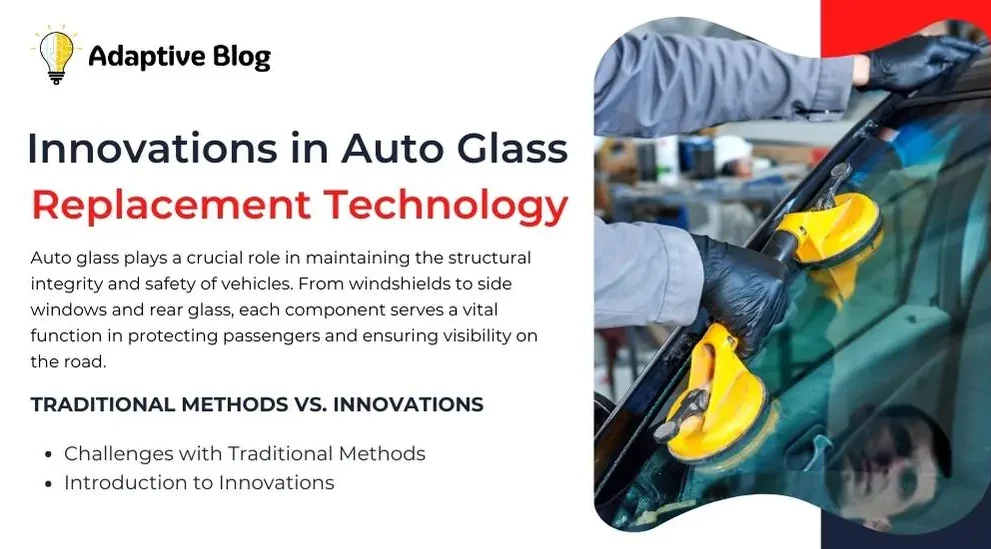Innovations in Auto Glass Replacement Technology

Introduction to Auto Glass Replacement
Auto glass plays a crucial role in maintaining the structural integrity and safety of vehicles. From windshields to side windows and rear glass, each component serves a vital function in protecting passengers and ensuring visibility on the road. However, due to various factors such as accidents, weather conditions, or wear and tear, auto glass often requires replacement.
Traditional Methods vs. Innovations
Challenges with Traditional Methods: Traditional auto glass replacement methods often pose several challenges. These methods were time-consuming, and labour-intensive, and sometimes led to inaccuracies in installation. Moreover, the use of conventional materials limited the effectiveness and durability of replacement solutions.
Introduction to Innovations: In recent years, significant innovations have transformed the landscape of auto glass replacement. These innovations encompass advanced materials, improved installation techniques, enhanced safety features, eco-friendly solutions, and cost-effective measures, offering numerous benefits to vehicle owners.
Advanced Materials Used
Smart Glass Technology: One of the most notable advancements in auto glass replacement is the integration of smart glass technology. The smart glass features electronic control systems that allow for dynamic adjustments in transparency, shading, and temperature. This innovation not only enhances comfort but also improves energy efficiency and aesthetics.
Impact-resistant Materials: Innovative materials such as laminated glass and tempered glass have revolutionized auto-glass replacement. These materials are designed to withstand high-impact forces, reducing the risk of shattering and enhancing overall safety. Additionally, advancements in nanotechnology have further strengthened glass surfaces, making them more resistant to scratches and cracks.
Improved Installation Techniques
Automated Installation Processes: The advent of automated installation processes has streamlined the replacement of auto glass. Robotic arms equipped with advanced computer vision systems can precisely position and secure glass components within milliseconds, ensuring optimal fit and alignment. This automation minimizes human error and enhances efficiency in the installation process.
Precision Tools and Techniques: Furthermore, the use of precision tools and techniques has significantly improved the quality of auto glass replacement. Laser measurement devices, 3D scanning technology, and computer-aided design software enable technicians to accurately assess vehicle dimensions and customize glass components accordingly. This precision ensures a perfect fit and eliminates potential gaps or leaks.
Enhanced Safety Features
Integration of Sensors and Cameras: Modern auto glass replacement solutions often incorporate sensors and cameras directly into the glass panels. These integrated systems provide advanced driver assistance features such as lane departure warnings, collision detection, and adaptive cruise control. By enhancing situational awareness, these safety features help prevent accidents and mitigate risks on the road.
Structural Reinforcements: Innovations in structural reinforcements have bolstered the integrity of auto glass components. Advanced adhesives and bonding techniques create a seamless bond between glass and vehicle frame, increasing resistance to impact forces and improving overall structural stability. This reinforcement ensures maximum protection for passengers in the event of a collision.
Eco-Friendly Solutions
Recyclable Materials: In response to growing environmental concerns, auto glass manufacturers have developed recyclable materials for replacement purposes. These eco-friendly solutions minimize the consumption of raw materials and reduce waste generation, contributing to sustainable practices in the automotive industry. Additionally, the use of recycled glass helps lower production costs and conserves energy resources.
Energy-efficient Glass: The introduction of energy-efficient glass has become a hallmark of innovation in auto glass replacement. Low-emissivity coatings and thermal insulation features enhance the thermal performance of vehicle interiors, reducing reliance on heating and cooling systems. This not only improves comfort for occupants but also reduces fuel consumption and greenhouse gas emissions.
Cost-effectiveness
Longevity and Durability: While innovations in auto glass replacement may entail initial investment, they offer long-term cost-effectiveness. Advanced materials and installation techniques result in durable glass components that require minimal maintenance over their lifespan. This longevity translates into savings for vehicle owners, as they incur fewer repair and replacement expenses over time.
Reduced Maintenance Costs: Moreover, the enhanced safety and functionality of modern auto glass solutions contribute to reduced maintenance costs. By minimizing the risk of damage and ensuring optimal performance, these innovations mitigate the need for frequent repairs and replacements. As a result, vehicle owners can enjoy peace of mind knowing that their auto glass is built to last.
Future Prospects
Continued Advancements: The future of auto glass replacement holds promising prospects for continued advancements. Ongoing research and development efforts aim to further enhance the performance, efficiency, and sustainability of replacement solutions. From integration with emerging technologies to novel manufacturing processes, the automotive industry remains at the forefront of innovation in auto glass technology.
Integration with Autonomous Vehicles: As the automotive landscape evolves towards autonomous vehicles, auto glass replacement will play a crucial role in supporting this transition. Innovations such as augmented reality displays, self-healing glass, and integrated sensors will become increasingly important for ensuring the safety and functionality of autonomous driving systems. By integrating seamlessly with vehicle automation, future auto glass solutions will redefine the passenger experience on the road.
Also Read: A Deep Dive into the Home Loan Application Process
Conclusion
Innovations in auto glass replacement technology have revolutionized the way vehicles are maintained and serviced. From advanced materials and installation techniques to enhanced safety features and eco-friendly solutions, these innovations offer numerous benefits for vehicle owners. As the automotive industry continues to evolve, the future holds exciting possibilities for further advancements in auto glass technology.





